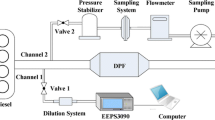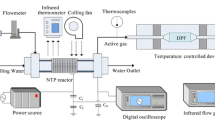Abstract
For the regeneration of diesel particulate filters (DPF) using non-thermal plasma (NTP), both cost-effectiveness and regeneration efficiency should be raised. This study compared and contrasted the physicochemical characteristics of carbon black and engine particulate matter (PM). After carbon black was put into the DPF, an experimental setup for the oxidation of PM using NTP was created. The findings showed that carbon black and PM samples had comparable oxidation traits, micro-nanostructures, and C/O elemental ratios. O3, the main active species in NTP, was susceptible to heat breakdown, and the rate of decomposition of O3 increases with increasing temperature. The removal effectiveness of carbon black first improved and subsequently declined with an increase in the NTP injection flow rate during offline DPF regeneration using NTP at room temperature. A relatively high carbon black removal efficiency of 85.1% was achieved at an NTP injection flow rate of 30 L/min.











Similar content being viewed by others
Data availability
The data will be available from the corresponding author upon a reasonable request.
References
Gao J, Chen H, Chen J, Ma C, Tian G, Li Y (2019) Explorations on the continuous oxidation kinetics of diesel PM from heavy-duty vehicles using a single ramp rate method. Fuel 248:254–257
Ruehl C, Smith JD, Ma Y, Shields JE, Burnitzki M, Sobieralski W, Ianni R, Chernich DJ, Chang MO, Collins JF, Yoon S, Quiros D, Hu S, Dwyer H (2018) Emissions during and real-world frequency of heavy-duty diesel particulate filter regeneration. Environ Sci Technol 52(10):5868–5874
Liu L, Shao G, Gong P, Wu Z, Chu J, Hu Y (2022) Density functional theory studies on ortho-position adsorption of SO3 at step sites of a CaO surface with SO2 and CO2. Fuel 310:122174
Munoz X, Barreiro E, Bustamante V, Lopez-Campos JL, Gonzalez-Barcala FJ, Cruz MJ (2019) Diesel exhausts particles: their role in increasing the incidence of asthma. Reviewing the evidence of a causal link. Sci Total Environ 652:1129–1138
Yildiz I, Caliskan H, Mori K (2021) Effects of cordierite particulate filters on diesel engine exhaust emissions in terms of pollution prevention approaches for better environmental management. J Environ Manage 293:112873
Alanen J, Saukko E, Lehtoranta K, Murtonen T, Timonen H, Hillamo R (2015) The formation and physical properties of the particle emissions from a natural gas engine. Fuel 162:155–161
Zhong H, Tan J, Wang Y, Tian J, Hu N, Cheng J, Zhang X (2017) Effects of a diesel particulate filter on emission characteristics of a China II non-road diesel engine. Energy Fuels 31:9833–9839
Chen K, Martirosyan KS, Luss D (2011) Temperature gradients within a soot layer during DPF regeneration. Chem Eng Sci 66(13):2968–2973
Choi S, Oh K, Lee C (2014) The effects of filter porosity and flow conditions on soot deposition/oxidation and pressure drop in particulate filters. Energy 77:327–337
Kuwahara T, Nakaguchi H, Kuroki T, Okubo M (2016) Continuous reduction of cyclic adsorbed and desorbed NO(x) in diesel emission using nonthermal plasma. J Hazard Mater 308:216–224
Kuwahara T, Yoshida K, Hanamoto K, Sato K, Kuroki T, Okubo M (2015) Effect of exhaust gas temperature on oxidation of marine diesel emission particulates with nonthermal-plasma-induced ozone. Ozone-Sci Eng 37(6):518–526
Shi Y, Cai Y, Fan R, Cui Y, Chen Y, Ji L (2019) Characterization of soot inside a diesel particulate filter during a nonthermal plasma promoted regeneration step. Appl Therm Eng 150:612–619
Babaie M, Kishi T, Arai M, Zama Y, Furuhata T, Ristovski Z, Rahimzadeh H, Brown RJ (2015) Influence of non-thermal plasma after-treatment technology on diesel engine particulate matter composition and NOx concentration. Int J Environ Sci Te 13(1):221–230
Shi Y, Zhou Y, Li Z, Cai Y, Li X, He Y, Jia F (2022) Effect of temperature control conditions on DPF regeneration by nonthermal plasma. Chemosphere 302:134787
Wang P, Gu W, Lei L, Cai Y, Li Z (2015) Micro-structural and components evolution mechanism of particular matter from diesel engines with non-thermal plasma technology. Appl Therm Eng 91:1–10
Sharma HN, Pahalagedara L, Joshi A, Suib SL, Mhadeshwar AB (2012) Experimental study of carbon black and diesel engine soot oxidation kinetics using thermogravimetric analysis. Energy Fuels 26(9):5613–5625
Zhu J, Lee KO, Yozgatligil A, Choi MY (2005) Effects of engine operating conditions on morphology microstructure and fractal geometry of light-duty diesel engine particulates. P Combust Inst 30(2):2781–2789
Ranji-Burachaloo H, Masoomi-Godarzi S, Khodadadi AA, Mortazavi Y (2016) Synergetic effects of plasma and metal oxide catalysts on diesel soot oxidation. Appl Catal B-Environ 182:74–84
Dinesh B, Aadhav A, Devi KSS, Krishnan UM (2022) Electrocatalytic reduction of 2,4 dinitrophenol on carbon black-modified glassy carbon electrode and its selective recognition in cold beverages. Carbon Lett 32:1017–1029
Zouaoui N, Brilhac JF, Mechati F, Jeguirim M, Djellouli B, Gilot P (2010) Study of experimental and theoretical procedures when using thermogravimetric analysis to determine kinetic parameters of carbon black oxidation. J Therm Anal Calorim 102(3):837–849
Samynaathan V, Iyer SR, Kesavan KS, Michael MS (2021) High-performance electric double-layer capacitor fabricated with nanostructured carbon black-paint pigment as an electrode. Carbon Lett 31:137–146
Naseri A, Sediako AD, Liu F, Barati M, Baker RD, Thomson MJ (2020) In-situ studies of O2 and O radical oxidation of carbon black using thermogravimetric analysis and environmental transmission electron microscopy. Carbon 156:299–308
Meng Z, Yang D, Yan Y (2014) Study of carbon black oxidation behavior under different heating rates. J Therm Anal Calorim 118(1):551–559
Tighe CJ, Twigg MV, Hayhurst AN, Dennis JS (2016) The kinetics of oxidation of diesel soots and a carbon black (Printex U) by O2 with reference to changes in both size and internal structure of the spherules during burnout. Carbon 107:20–35
Juan O, Meng Z, Hu Y, Du Y (2021) Experimental investigation on the variation characteristics of soot layer thickness and pressure drop during DPF/CDPF active regeneration. Chem Eng Sci 241:116682
Meng Z, Zeng B, Tan J, Chen Z, Ou J (2022) Study of gas and particulate emission characteristics during the fast regeneration period of DPF. Fuel 317:123353
Stratakis GA, Stamatelos AM (2003) Thermogravimetric analysis of soot emitted by a modern diesel engine run on catalyst-doped fuel. Combust Flame 132:157–169
Wang Y, Liang X, Tang G, Chen Y, Dong L, Shu G (2017) Impact of lubricating oil combustion on nanostructure composition and graphitization of diesel particles. Fuel 190:237–244
Song J, Alam M, Boehman A, Kim U (2006) Examination of the oxidation behavior of biodiesel soot. Combust Flame 146(4):589–604
Cavallo DM, Chiavola O, Palmieri F, Mancaruso E, Vaglieco BM (2023) Experimental study on the effect of loading and regeneration for an optimized management of the DPF. Rineng 18:101048
Yao S, Wu Z, Han J, Tang X, Jiang B, Lu H, Yamamoto S, Kodama S (2015) Study of ozone generation in an atmospheric dielectric barrier discharge reactor. J Electrostat 75:35–42
Liu L, Shao G, Ma C (2023) Plasma-catalysis for VOCs decomposition: a review on micro- and macroscopic modeling. J Hazard Mater 451(2):131100
Okubo M, Kuroki T, Kawasaki S, Yoshida K, Yamamoto T (2009) Continuous regeneration of ceramic particulate filter in stationary diesel engine by nonthermal-plasma-induced ozone injection. IEEE T Ind Appl 45(5):1568–1574
Zhu K, Cai Y, Shi Y, Lu Y, Zhou Y, He Y (2021) The effect of nonthermal plasma on the oxidation and removal of particulate matter under different diesel engine loads. Plasma Process Polym 19(1):2100104
Gu L, Cai Y, Shi Y, Wang J, Pu X, Tian J, Fan R (2017) Effect of indirect non-thermal plasma on particle size distribution and composition of diesel engine particles. Plasma Sci Technol 19(11):115503
Zou J, Wu S, Liu Y, Sun Y, Cao Y, Hsu JP, Wee ATS, Jiang J (2018) An ultra-sensitive electrochemical sensor based on 2D g-C3N4/CuO nanocomposites for dopamine detection. Carbon 130:652–663
Jiang J, Bai S, Yang M, Zou J, Li N, Peng J et al (2022) Strategic design and fabrication of mxenes-Ti3CNCl2@CoS2 core-shell nanostructure for high-efficiency hydrogen evolution. Nano Res 15:5977–5986
Jiang J, Xiong Z, Wang H, Liao G, Bai S, Zou J et al (2022) Sulfur-doped g-C3N4/g-C3N4 isotype step-scheme heterojunction for photocatalytic H2 evolution. J Mater Sci Technol 118:15–24
Zou J, Liao G, Jiang J, Xiong Z, Bai S, Wang H et al (2022) In-situ construction of sulfur-doped g-C3N4/defective g-C3N4 isotype step-scheme heterojunction for boosting photocatalytic H2 evolution. Chinese J Struc Chem 41:2201015–2201033
Shi Y, Lu Y, Cai Y, He Y, Zhou Y, Fang J (2022) Evolution of particulate matter deposited in the DPF channel during low-temperature regeneration by non-thermal plasma. Fuel 318:123552
Yan Q, Li J, Cai Z (2021) Preparation and characterization of chars and activated carbons from wood wastes. Carbon Lett 31:941–956
Cabielles M, Rouzaud J, Garcia AB (2009) High-resolution transmission electron microscopy studies of graphite materials prepared by high-temperature treatment of unburned carbon concentrates from combustion fly ashes. Energy Fuels 23:942–950
Sadezky A, Muckenhuber H, Grothe H, Niessner R, Pöschl U (2005) Raman microspectroscopy of soot and related carbonaceous materials: spectral analysis and structural information. Carbon 43(8):1731–1742
Chadha N, Sharma R, Saini P (2021) A new insight into the structural modulation of graphene oxide upon chemical reduction probed by Raman spectroscopy and X-ray diffraction. Carbon Lett 31:1125–1131
Reddy S, Shukla B, Chakraborty S, Srihari V, Bhalerao G, Shekar N (2022) Study on high-pressure behaviour of spherical carbon black nanoparticles with core–shell structure. Carbon Lett 32:1377–1377
Beyssac O, Goffe B, Petitet JP, Froigneux E, Moreau M, Rouzaud JN (2003) On the characterization of disordered and heterogeneous carbonaceous materials by Raman spectroscopy. Spectrochim Acta A 59(10):2267–2276
Acknowledgements
This work was supported by the National Natural Science Foundation of China (No. 52276115) and the Major Projects of Natural Science Research in Colleges and Universities in Jiangsu Province (No.21KJA470001).
Funding
This study was funded by The National Natural Science Foundation of China, No. 52276115, Yunxi Shi, the Major Projects of Natural Science Research in Colleges and Universities in Jiangsu Province, No. 21KJA470001, Yunxi Shi
Author information
Authors and Affiliations
Corresponding author
Ethics declarations
Conflict of interest
On behalf of all authors, the corresponding author states that there is no conflict of interest.
Additional information
Publisher's Note
Springer Nature remains neutral with regard to jurisdictional claims in published maps and institutional affiliations.
Rights and permissions
Springer Nature or its licensor (e.g. a society or other partner) holds exclusive rights to this article under a publishing agreement with the author(s) or other rightsholder(s); author self-archiving of the accepted manuscript version of this article is solely governed by the terms of such publishing agreement and applicable law.
About this article
Cite this article
Chen, X., Shi, Y., Cai, Y. et al. Effect of non-thermal plasma injection flow rate on diesel particulate filter regeneration at room temperature. Carbon Lett. 34, 1075–1089 (2024). https://doi.org/10.1007/s42823-023-00675-0
Received:
Revised:
Accepted:
Published:
Issue Date:
DOI: https://doi.org/10.1007/s42823-023-00675-0




